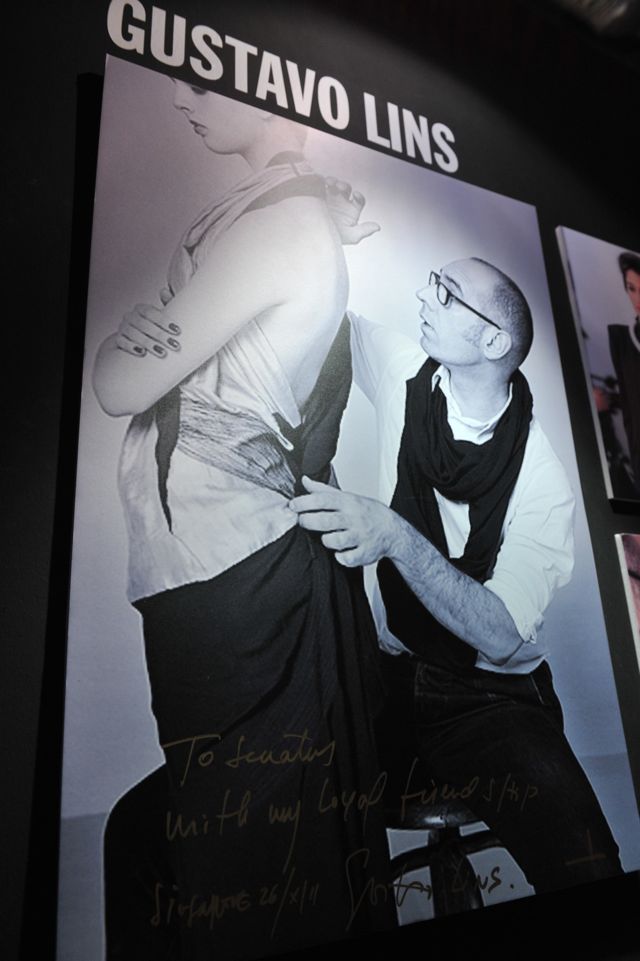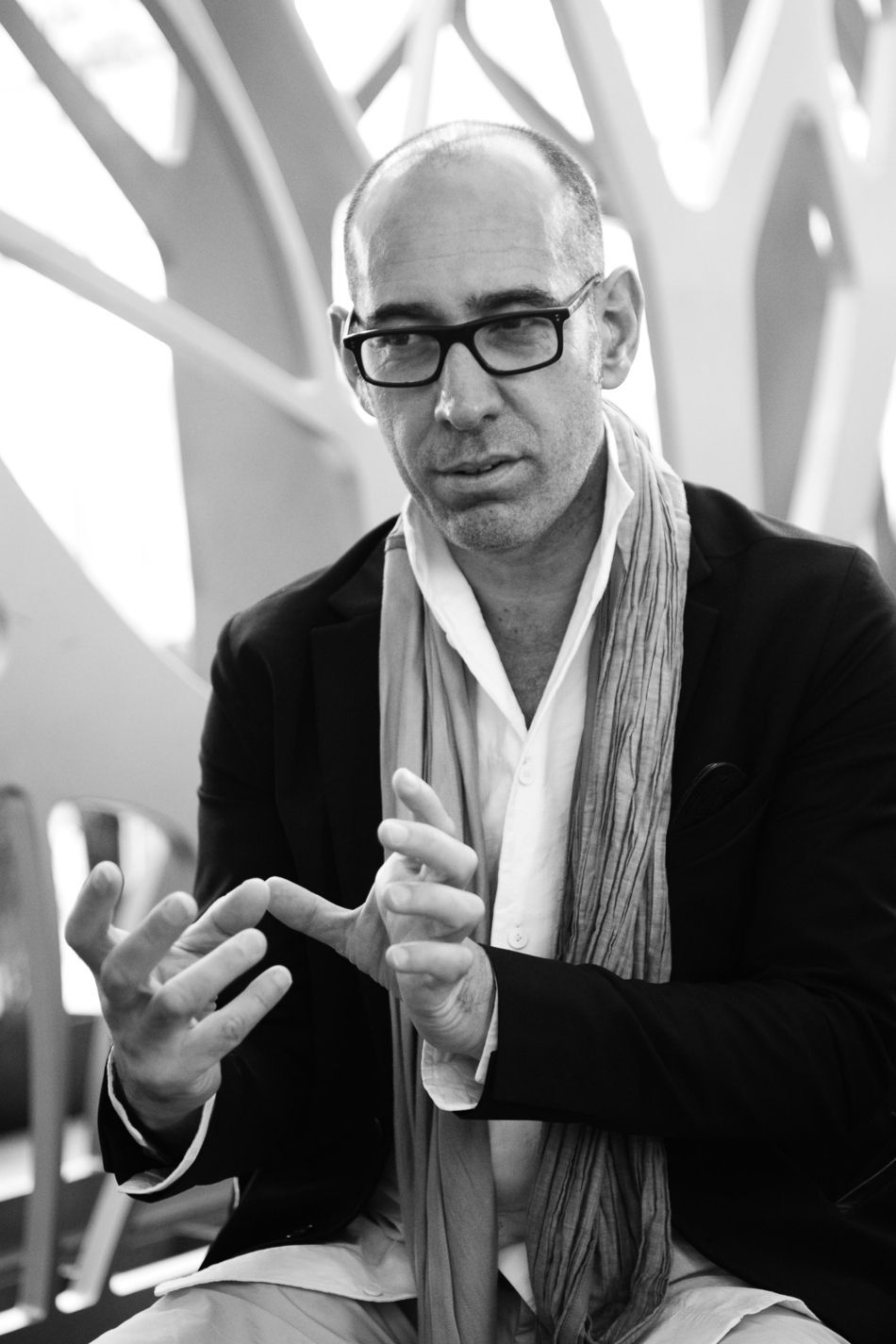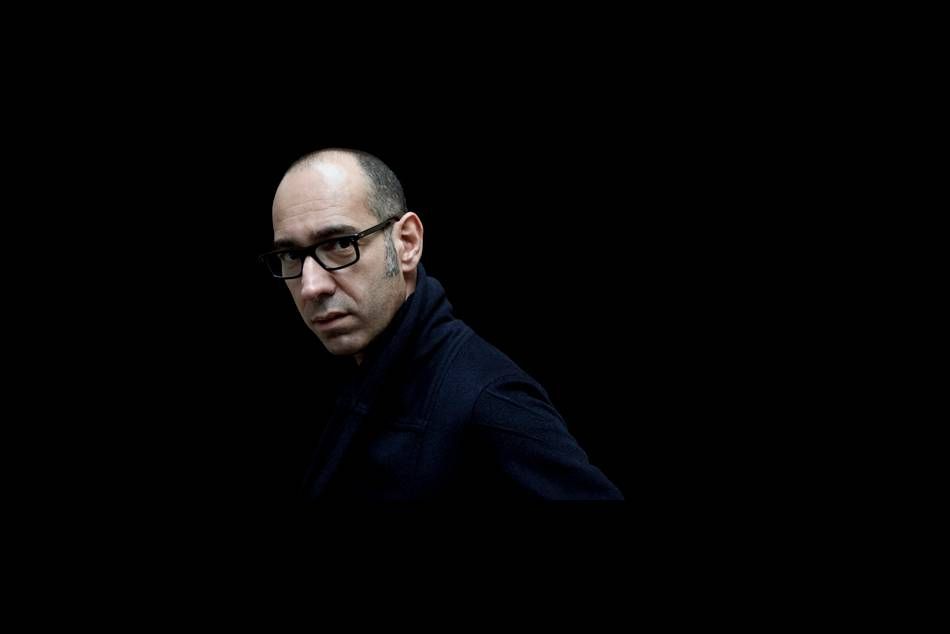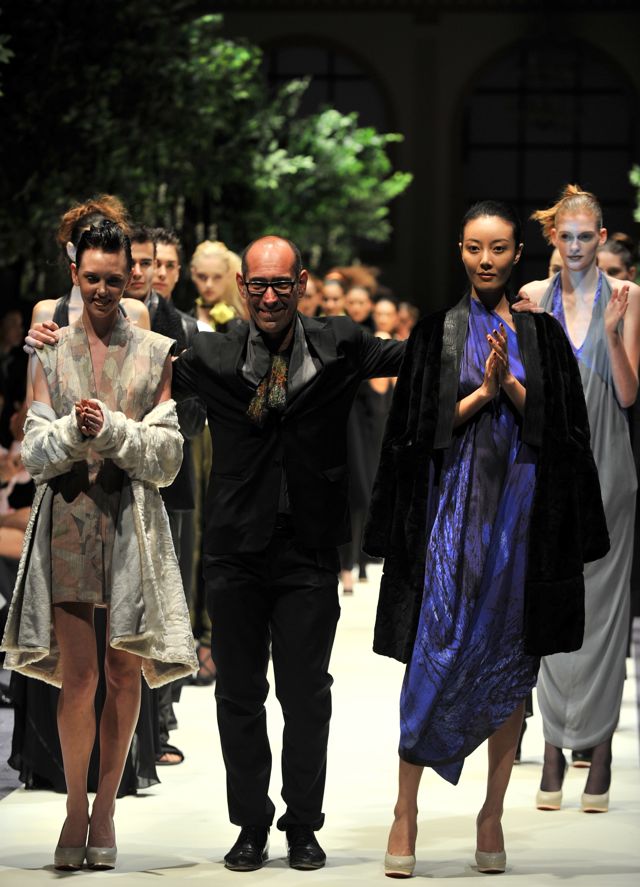By Cheryl Tay
SENATUS spoke to Gustavo Lins during Women's Fashion Week 2011 Singapore, ahead of the upcoming Haute Couture Week in Paris come late January 2012, and is part of SENATUS' Masters of Luxury interview series for 2012.
Gustavo Lins made interviewing him a piece of cake – the designer is full of infectious enthusiasm about his work and does not hold back. He tells us of his inspiration in Singapore, how he founded his brand and the philosophy behind his style.
On seeing the photograph (of him draping silk around a model) we had brought along for him to sign, he immediately began telling the story behind it.
Tell us about the story behind this photograph
Five years ago I dropped some haute kimonos into clay, and draped them to create movements. Working with soft material that would become solid was a great experience to know how haute couture could be a sort of laboratory for trying new ideas.
 After being a pattern-maker for years, I had thousands of remains of patterns and toiles in my studio.
After being a pattern-maker for years, I had thousands of remains of patterns and toiles in my studio.
Instead of throwing them away, I decided to transform them into new products by creating some panels displaying toiles and also some mannequins in paper. Some people from Germany saw this and asked if I would like to work with them using porcelain, a material that registers every slight movement you put out. I was very surprised because I had never worked with clay in my life. I arrived in Germany in 30 days later, and built a bust in clay, draping around the bust using the same movement I put in my clothes, exactly like in the picture.
The sculptures I made are displayed in the showroom during Women’s Fashion Week.
Could you tell us about your creative process?
When I work I’m like a child; I play with the materials. This is my work ethic: instead of contemplating what to do, I take material and fold it, putting it this way and that to see if it works.
When I have fabrics in my hands, I know how to construct the collection. Fabrics are for me the beginning of the development. After that, colours and shapes. I draw at the beginning, and at the end, never in the middle. I construct clothes directly on the mannequin to get the real design. One of my assistants does the technical drawings, and on the technical drawings, I change the proportion of the detailing.
I try to stay a very simple person because my work is difficult and I have to find inspiration and new ideas every second of my life; if I don’t stay curious about everything I cannot create. When I’m in the city I’m very normal, I love to take the bus, the subway, and meet new people. When I go back to my studio I read a lot, and try to understand how people change throughout history. Human beings for me are the most important points of my work. Without human beings my clothes are just objects; when men and women wear my clothes they become spaces.

How did you get started in the fashion business?
I never went to fashion school; I am an autodidact. I learnt for three years by opening books on tailoring techniques and sewing. Then I presented myself to a couture house in Paris, and worked there for a year as a simple worker, just sewing.
I learnt how to make good clothes from the chief of the studio, a lady who had worked with Balenciaga, Valentino and Pierre Cardin. It gave me a solid foundation in the basis of the profession. After that I went into the technique of cutting.
 I worked as a pattern-maker for many brands like Kenzo, Louis Vuitton, Jean-Paul Gaultier, and Galliano so I was in contact with the process of creating haute couture.
I worked as a pattern-maker for many brands like Kenzo, Louis Vuitton, Jean-Paul Gaultier, and Galliano so I was in contact with the process of creating haute couture.
When I started my brand seven years ago, my goal was to create a sort of new haute couture by mixing industries and craftsmen to produce garments. I am a mix of haute couture and ready-to-wear. Our clothes are made in an haute couture setting because everything is unique and made on mannequins, and after finding the silhouette, you immediately have a pattern on paper or software that is able to be reproduced to innumerable units.
In my career, I climbed every ladder, much like someone from Asia. I’m sure that someone from Asia, when he does something, he will try to do everything, so that at the end he will have a perfect work. I think that to direct people, you must know how to make it yourself; otherwise you have no authority. Good design comes from real values.
SENATUS: How did you come up with the idea to hide your label under a triangle?
GL: I was looking for a signature for my label: a geometrical shape. I had my name written in front of me – Gustavo – and in the middle of my name was a "T" so I took this "T" as a reference. On the wall was my T-rule from when I studying architecture. At that time I was working on the darts of the back of a jacket; instead of having two darts on the back I wanted to have just one. By a single movement I found an inverted "T" on the back. I saw my name, I saw the rule, I had three things at the same time that were connected in a matter of three seconds and I said "Okay, that’s my brand."
Two weeks later I went to the trade Chambre to register the company and protect this inverted “T” and our history began. It was very simple but I had worked for 14 years to reach this point.
I was also trying to design a reversible piece because if I turn my jacket inside out and the label is visible, it’s very vulgar. I don’t want to have my name visible. So working on a square, I thought of how to hide my name: by folding it. The square is the basis of my work. I measured a kimono and discovered the proportion between the length and the width gives a square. Studying both architecture and fashion design, I was trying to establish the connection between architecture and garments, which led me to the kimono.
Tatami is the basis of Japanese architecture. The kimono is a reflection of a tatami mat because when you sleep you wear a kimono, so the kimono corresponds to the proportions of tatami; and tatami corresponds to the proportions of the human body.
I could fold the square many ways to hide my name, but I was looking for something very simple so I took a piece of leather sewed my name on and folded it and that was it – it’s like an envelope – and clothes are like an envelope.

How would you describe your distinctive style?
I produce both women and men’s designs. First I begin with men’s designs, creating seven outfits for men and I take three outfits from menswear to womenswear. A pair of trousers, a coat, or a shirt. This is because the difference between men and women is very strong, and to recognize a brand, it’s very important to have distinctive signs. I also love to drape masculine fabrics into jackets, and soft wool that generally is employed for men’s suits into dresses, jackets, scarves and blouses. The other point is the mix of masculine coats and feminine draped dresses. The combination for me is an important point of my work, the masculine and feminine of the same level.
For this collection in Singapore I decided on seven new outfits especially for the show, which will be shown in Singapore before they are shown in Paris. When I came to Singapore in September, it left such a deep impression on me that when I went back to Paris, I told my team I would like to create something new I have never done before. That’s why I increased this collection.
How are the designs that you have designed for the Singapore collection different from the rest of your collection?
There are some novelties because there are long coats, I have never designed coats with long tails; there are openings on the back, there are small knots in leather, very simple nice knots, and this yellow colour is very new. You will see tomorrow, and maybe you can give your impression!
 SENATUS: What prompted you to invite Dr. Georgia Lee to open your show during WFW?
SENATUS: What prompted you to invite Dr. Georgia Lee to open your show during WFW?
I am a very lucky man because when I asked Dr. Georgia Lee if she would open our show, she said yes, of course. She came to my studio for a fitting, and she was so kind with my assistants and we could talk about medicine. She told me when she saw my panels, she was reminded of surgery.
I thought about my father, a surgeon, and how he told me to observe the human body and study anatomy because you must know your body to know yourself, to know how you are made. When I design clothes I took these lessons from my father and mixed tailoring rules with anatomy rules.
We were discussing this and she told me "You’re totally right, when we wear your designs, we feel comfortable and we feel you can follow the shape and lines of the body."
SENATUS: What have you been inspired by for your upcoming collection?
My inspiration for the new collection is Spanish. I lived in Spain for three years and there I have my personal tailor and I took my private lessons in tailoring-making. The beginning of my work was in Spain and I’d like to talk about the traditional Spanish clothes creating the link between tailoring and kimonos. In this collection you will see one sign you will see in Paris in January: dots.
Some clothes I will show here will be shown in January in Paris, so it’s a preview for you. The shapes I show here will be remade in different palettes, what you have here is exclusive. It’s my way to create a mark and to establish the timing in the calendar, because I hope this Haute Couture week will remain in the calendar. It’s a very good opportunity for us in Europe to come to Singapore to show our work and vice versa. Let’s wait for the reaction of the public and see how it works, but I really hope this haute couture week could be something new in the haute couture business.
I am convinced that in this part of Asia, many people could be interested in new designers because they already have brands like Dior, Chanel and Givenchy… This curiosity in new designers is very new, and I think you are the first ones in the world that understand the philosophy of Chambre Syndicale nowadays.
I will do my best to defend this Fashion Week because it is very important to have another place than Paris to show haute couture. Also it is perfect timing because now is not an important time on the world on the fashion calendar.
Grand Couturier Gustavo Lins showcased his Fall/Winter 2011/2012 Haute Couture collection at Women's Fashion Week held at Marina Bay Sands in Singapore. The Brazilian-borned designer brought out both his womenswear and menswear haute couture collections on display. See more photos: //senatus.net/album/view/2549/











